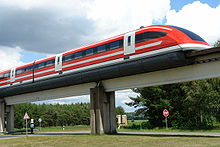
Back Magneetsweeftrein Afrikaans Mæȝuppā ANG قطار مغناطيسي معلق Arabic Tren de levitación magnética AST Маглеў Byelorussian Маглеў BE-X-OLD Маглев Bulgarian চুম্বক-উত্তোলিত রেল Bengali/Bangla Trenioù a levitadur magnetek Breton Tren Maglev Catalan


Maglev (derived from magnetic levitation) is a system of rail transport whose rolling stock is levitated by electromagnets rather than rolled on wheels, eliminating rolling resistance.[1][2]
Compared to conventional railways, maglev trains can have higher top speeds, superior acceleration and deceleration, lower maintenance costs, improved gradient handling, and lower noise. However, they are more expensive to build, cannot use existing infrastructure, and use more energy at high speeds.[3]
Maglev trains have set several speed records. The train speed record of 603 km/h (375 mph) was set by the experimental Japanese L0 Series maglev in 2015.[4] From 2002 until 2021, the record for the highest operational speed of a passenger train of 431 kilometres per hour (268 mph) was held by the Shanghai maglev train, which uses German Transrapid technology.[5] The service connects Shanghai Pudong International Airport and the outskirts of central Pudong, Shanghai. At its historical top speed, it covered the distance of 30.5 kilometres (19 mi) in just over 8 minutes.
Different maglev systems achieve levitation in different ways, which broadly fall into two categories: electromagnetic suspension (EMS) and electrodynamic suspension (EDS). Propulsion is typically provided by a linear motor.[6] The power needed for levitation is typically not a large percentage of the overall energy consumption of a high-speed maglev system.[7] Instead, overcoming drag takes the most energy. Vactrain technology has been proposed as a means to overcome this limitation.
Despite over a century of research and development, there are only six operational maglev trains today — three in China, two in South Korea, and one in Japan.[8][9]
- ^ "Japanese Maglev Train: World's Fastest Bullet Train - JRailPass". 27 February 2017. Archived from the original on 15 July 2022. Retrieved 18 July 2022.
- ^ "Magnetic Levitation - an overview | ScienceDirect Topics". Archived from the original on 18 July 2022. Retrieved 18 July 2022.
- ^ "Will maglev ever become mainstream?". www.railway-technology.com. 17 January 2018. Archived from the original on 4 June 2021. Retrieved 4 June 2021.
- ^ "Japan's maglev train breaks world speed record with 600km/h test run". The Guardian. United Kingdom: Guardian News and Media Limited. 21 April 2015. Archived from the original on 6 December 2019. Retrieved 21 April 2015.
- ^ "Everything about Shanghai Maglev Train: Speed, Station, Map, Ticket & Price, Facts..." www.chinadiscovery.com. Retrieved 19 November 2023.
- ^ Yaghoubi, Hamid (27 March 2013). "The Most Important Maglev Applications". Journal of Engineering. 2013: e537986. doi:10.1155/2013/537986. ISSN 2314-4904.
- ^ Transrapid Archived 27 September 2013 at the Wayback Machine uses more power for air conditioning
- ^ "The Six Operational Maglev Lines in 2018". www.maglev.net. Archived from the original on 28 November 2020. Retrieved 23 November 2021.
- ^ "High-speed rail trains are stalled in the US—and that might not change for a while". Popular Science. 5 October 2022. Archived from the original on 26 December 2022. Retrieved 26 December 2022.
© MMXXIII Rich X Search. We shall prevail. All rights reserved. Rich X Search